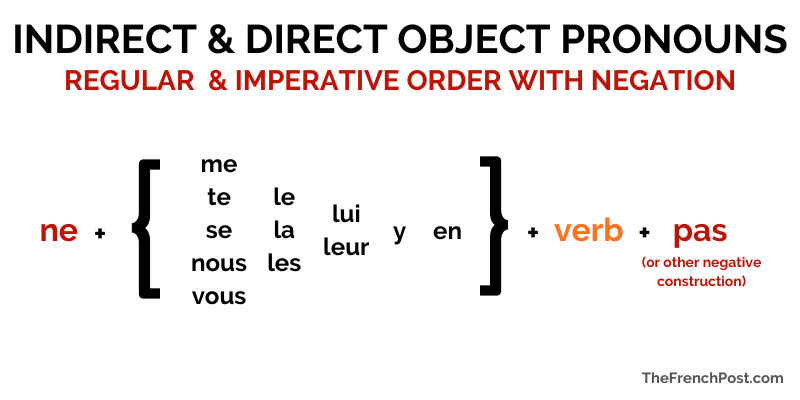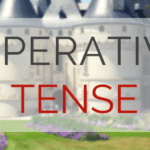
The concept of negatives in French isn’t much different from expressing negative concepts in English. In both languages you’re pointing out the absence of a thing, action, place, ec.
Forming negatives in French sentences
The major difference in French is that negative phrases come with two parts (ne + another word). In most sentences the ne and the other word get placed on either side of the verb they’re referring to. (In spoken French the ne is often dropped, but it’s important to understand how to formally form negatives in French.)
Using Ne…Pas
The most common negative construction in French is ne…pas, which forms a “sandwich” around the verb in the present tense and means the verb does NOT happen. For example, in the present tense you might say:
Je veux le livre. (“I want the book.”) → Je ne veux pas le livre. (“I do not want the book.”)
In imperative sentences, this pattern holds true, and the negation goes around the verb command. For example:
Mentez à vos parents! → Ne mentez pas à vos parents! (“Do not lie to your parents!”)
Using Ne…Pas De
When you are negating a sentence that has either an indefinite article (un/une) or a partitive article (du/de la/des), the original article gets dropped and is replaced by de, regardless of whether the noun it’s referring to is feminine or masculine, and singular or plural.
The pas de basically translates to “not any”.
J’ai mangé une cerise. → Je n’ai pas mangé de cerises. (“I did not eat any cherries.”)
J’aime les chansons américains. → Je n’aime pas de chansons américains. (“I do not like any American songs.”)
Where to place negatives in French sentences
The order and position of negatives in French changes for certain types of verbs and sentence structures.
In compound verb tenses…
In compound (two-part) verb tenses, the negation goes around the first (conjugated) verb, not the past participle. For example, in the passé composé past tense:
J’ai fait mes devoirs. → Je n‘ai pas fait mes devoirs. (“I did not do my homework.”)
The same order holds for the plus-que-parfait past tense:
La voiture avait été lavée. → La voiture n‘avait pas été lavée. (“The car had not been washed.”)
In the immediate future (le future proche)
The immediate future construction is not its own tense (it uses the conjugated form of aller + a verb infinitive), but its negation also goes around the first (conjugated) verb. For example:
Ils vont regarder le film ce soir. → Ils ne vont pas regarder le film ce soir. (“They are not going to watch the movie tonight.”)
Ne… pas in Infinitives
Speaking of infinitives, to convey the message that you are not doing a verb described in its infinitive form, use ne pas + the infinitive form.
J’apprends à mentir → J’apprends à ne pas mentir (“I am learning not to lie.”)
Il est important d’écrire dans votre livre → Il est important de ne pas écrire dans votre livre. (“It is important not to write in your book.”)
Negatives in French Vocabulary Words
There are several other French negative forms that follow the same general construction as in ne…pas, but replacing pas with one of the negatives below. They can serve as adverbs, adjectives, or pronouns in sentences.
Negative Adverbs
In general, negative adverbs in French refer to how a verb is NOT done.
| Ne….personne | No one |
| Ne…rien | Nothing |
| Ne…jamais | Never |
| Ne…que | Only |
| Ne…ni…(ni) | Neither…nor… (nor) |
| Ne…nullement | Not at all |
| Ne…guère | Hardly, barely |
| Ne…plus | Not anymore |
| Ne… nulle part | Nowhere/anywhere |
The ne should precede the verb, and like other adverbs, the second part of the negative phrase should be placed immediately after the verb or other adverb they are modifying. For example:
Ma sœur ne danse qu‘avec son petit ami. (“My sister only dances with her boyfriend.”)
Il ne pleure jamais. (“He never cries.”)
If the verb takes a direct object, keep the verb and direct object together (just like you would with any other adverb). For example:
On ne voit le chien nulle part. (“We don’t see the dog anywhere.”)
Negative Adjectives
Negative adjectives refer to what a noun or pronoun is NOT like.
| Ne…nul(le) | Not any |
| Ne…aucun(e) (de) | (Not) Any (of) |
| Ne…pas un(e) seul(e) (de) | Not a single one (of) |
Just like any other adjective in French, negative adjectives take the gender of the noun they’re modifying (but not the number, because negative constructions are always conjugated in the singular). For example, notice the difference between referring to un ordinateur portable:
Je ne vois aucun ordinateur portable ici. (“I do not see any laptops here.”)
Compared to using the feminine noun une robe (“a dress”):
Je n‘aime pas une seule robe de ce magasin. (“I don’t like a single dress from this store.”)
The phrase ne…nul(le) applies to nouns that are uncountable. For example:
Je n‘ai nul espoir. (“I have no hope.”)
Negative Pronouns
French negative constructions can be used as the subject, direct object, or object of the preposition of a sentence. The following negative phrases from above can also be used as pronouns:
| Ne…nul(le) part | Nowhere, anywhere |
| Ne…aucun(e) | (Not) Any |
| Ne…pas un(e) seul(e) | Not a single one |
| Ne….personne | No one |
| Ne…rien | Nothing |
Vous ne savez rien de ce sujet. (“You know nothing about this topic.”)
Je n‘entends personne dans la maison (“I don’t hear anyone in the house.”)
Negative Phrases as the Subject of a Sentence
For cases where the negative pronoun is the subject of the sentence, both parts of the negative construction go together at the beginning of the sentence. For example:
Personne ne sait pourquoi. (“No one knows why.”)
Nulle part n‘est aussi confortable que ma maison. (“Nowhere is as comfortable as my house.”)
When a negative adjective phrase is the subject of the sentence, the first part of the negative phrase precedes the subject of the sentence, and the ne follows the subject. For example:
Pas un seul de mes collègues ne travaille aujourd’hui. (“Not a single one of my coworkers is working today.”)
Aucun de mes coéquipiers ne sait comment jouer à ce jeu. (“None of my teammates know how to play this game.”)
Notice that these negative adjectives follow the ne… pas de construction mentioned earlier: the de never changes to des, du, or de la.
Negatives in French Word Order in Compound Sentences
In most two-part verb phrases, the ne goes first, followed by the first verb and then either the infinitive or the second verb (in compound verb tenses), followed by the second part of the negative form.
For example, in the present tense + infinitive form and in the immediate future:
Je ne veux aller nulle part. (“I do not want to go anywhere.”)
Je ne vais trouver aucun. (“I am not going to find any”)
An exception to this order is that when the negative phrase is an adverb, it generally goes after the first verb. For example:
Je ne vais jamais essayer ça. (“I am never going to try that.”)
In compound verb tenses like the passé composé and the past conditional, negative adjectives and pronouns go after both verbs. For example:
Je n‘ai dit personne (“I told no one”)
Je n‘aurais été heureux nulle part. (“I would not have been happy anywhere.”)
However, with negative adverbs, again the adverb will generally follow the first verb.
Ils n‘auraient plus ri. (“They would not have laughed anymore.”)
Je n‘aurais jamais dit que si j’avais su. (“I would never have said that if I had known.”)
Special word order rules for rien
With rien, in two-part verb constructions like the immediate future and the present + infinitive, rien goes immediately after the infinitive verb. For example:
Elle ne va rien acheter aujourd’hui. (“She’s not going to buy anything today.”)
Il ne peut rien voir. (“He can’t see anything.)
Similarly, in compound verb tenses, the rien goes immediately after the first verb. For example:
Je n‘ai rien dit. (“I did not say anything.”)
Je n‘ai rien découvert. (“I discovered nothing.”)
When the negative is the subject of the sentence in two-part sentences
Finally, when you have a negative, two-part phrase that’s also the subject of the sentence, the two parts of the negative phrase precede both verbs, with the ne coming second. For example:
Personne n‘est venu. (“No one came.”)
Rien n’a été livré. (“Nothing has been delivered.”)
Ni la lecture ni l’écriture n‘ont rendu mon ami heureux. (“Neither reading nor writing made my friend happy.”)
Negatives in French and Direct and Indirect Object Pronouns
There’s one more factor to consider when you’re mastering French negation: where to fit in the object pronouns?
When you are using “normal” nouns, their location in the sentence almost always matches up with where you would place the noun in English. But with French object pronouns, you’ll need to think through where to place them in any sentence with a negative construction.
In our direct and indirect object pronouns lesson, we discuss object pronouns and negation more thoroughly, but the most important thing to learn is the order that object pronouns are used in sentences (which is the same order for both normal and imperative sentences when you’re using negation).

This chart shows the order that is used in both simple and compound tenses. For example:
Elle ne m‘a présenté personne. (“She introduced me to no one.”)
Nous n‘y allons plus (“We don’t go there anymore”)
Il ne nous le montre pas. (“He does not show us it.”)
Je ne les vois pas (“I do not see them.”)
Je ne leur montrerai rien. (“I will show them nothing.”)
With the immediate future and verb + infinitive
However, in the immediate future and present tense + infinitive constructions, the ne…pas (or other negation) goes around the conjugated present tense verb (which is always aller for the immediate future) and before the object pronoun and the verb infinitive. For example:
Ils ne vont pas nous appeler. (“They are not going to call us.”)
Nous n‘allons pas le prendre (“We are not going to take it.”)
Je ne peux pas l‘attraper. (“I can’t catch it.”)
Next Steps after Negatives in French
And that covers all of the major concepts in French negation! That was a lot, right? From here, you might want to work on your subject or object pronouns, or learn more about the immediate future and immediate past.




some help with a double negative, ie. il ne restait donc plus que jean, i think it means only john was left
Thanks for asking – yes, I would say that conveys the meaning of the sentence well. “Il ne reste [or restait] donc plus que…” is a fairly common idiomatic saying in French. It can be translated in multiple ways in English, including describing that only one issue (or question, or object, or person) is left to address. A more literal translation for your sentence might be, “Therefore, there remained nothing more than John.”
I wouldn’t think of this as a double negative – instead, I would suggest just memorizing the phrase and what it means, since a direct translation doesn’t really exist in English.
Bonjour! J’ai une question de negative en français! Je veUx savoir (pardon je dois parler en anglais maitenant!) how to use the negative in a sentence with an infinitive. Pour example, how do i say… I try to Not forget… Merci!
Hi E, thank you for your excellent question! I will add this concept to the post, but to answer your question, “not” + infinitive in English (so, “not to forget” in your example), is ne pas + infinitive in French.
I try not to forget => J’essaie de ne pas oublier.
Very simple, but it can look a little weird the first time you see it. Hope that made sense!